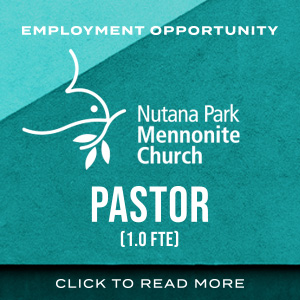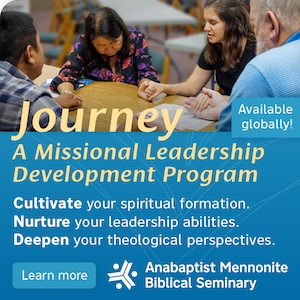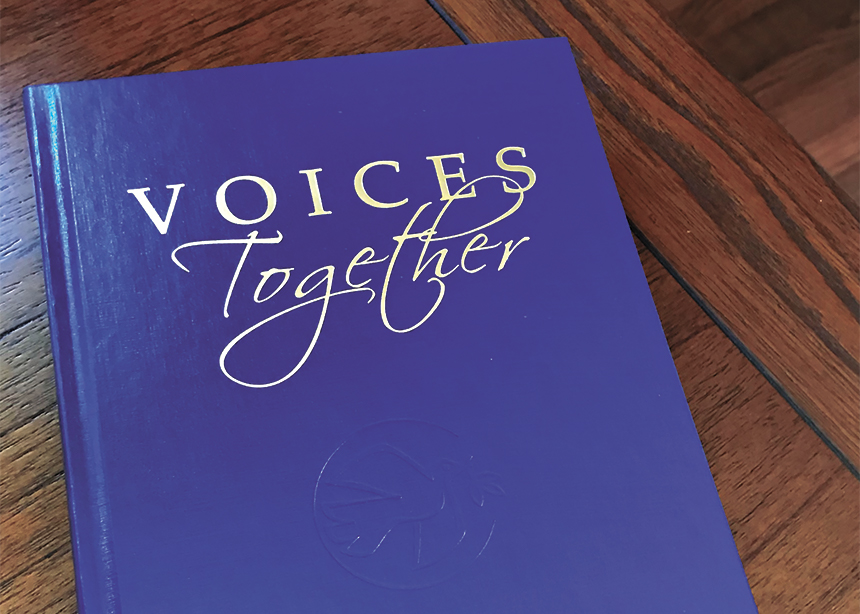It’s the result of an idea proposed over a decade ago and the culmination of more than four years of intense work. It includes close to a thousand hymns and worship resources that were chosen from a body of work more than 10 times that number. It represents the efforts of hundreds of Mennonites from across Canada and the United States.
It’s the new Voices Together hymnal—the successor to 1992’s Hymnal: A Worship Book and its two supplements, Sing the Journey (2005), and Sing the Story (2007)—and it arrives this month, containing hymns and worship resources in more than 40 languages that will serve congregations throughout Mennonite Church Canada and MC U.S.A. for decades to come.
“In a lot of Mennonite congregations, especially in Canada and the United States, hymnals are our primary theological document. . . . It’s the theology that we memorize, that we internalize, that comes back to us when we need it,” says Sarah Kathleen Johnson, who served on the Mennonite Worship and Song Committee, the 13-member binational group responsible for curating the hymnal. “In addition to forming individuals, it’s also shaping the larger Mennonite sense of community and identity.”
To learn about the work that went into producing the new hymnal, Canadian Mennonite spoke with five of the six Canadian members of the committee, as well as Bradley Kauffman of Elkhart, Ind., who was hired by MennoMedia to serve as general editor.
“Making a hymnal is a bigger project than probably any of us could ever have imagined,” says Darryl Neustaedter Barg, a committee member from Winnipeg. “I didn’t really know what I was getting into, as most of us on the committee would probably attest.”
‘It was a no-brainer’
Anneli Loepp Thiessen recalls the excitement she felt when MennoMedia started advertising that it was looking for committee members. The 25-year-old, who grew up in southern Ontario, was a fourth-year music student at Canadian Mennonite University (CMU) in Winnipeg when she submitted her application. A song leader, classical musician and music educator, Loepp Thiessen has been interested in church music and worship for much of her life.
“You would have been hard-pressed to convince me not to apply,” says Loepp Thiessen, who is now working on a doctorate in interdisciplinary music research at the University of Ottawa. “Honestly, it was a no-brainer.”
Paul Dueck of Cartier, Man., had a similar experience. A retired high-school and college music teacher who has led singing and worship throughout North and South America, Dueck has a deep love for the church and its music.
Melissa Miller, a MennoMedia board member and Dueck’s pastor at the time, encouraged him to apply. “I didn’t hesitate too long,” says Dueck, 64. “I thought, hey, might as well give it a try.”
Neustaedter Barg, who works in communications and media at MC Manitoba and CMU, applied after receiving encouragement from a handful of people. The 51-year-old has a long history of involvement with church music, from leading worship with MC Manitoba’s Camps With Meaning ministry to leading singing at a number of Canadian and binational Mennonite gatherings.
He loves church music of all sorts but is keenly aware that churches throughout MC Canada and MC U.S.A. are singing more than just hymns. “I have been pretty vocal about needing to pay attention to a broader musical palette, so I guess I came in with that agenda,” he says. “I didn’t assume my personal agenda could sway a whole hymnal committee . . . but it sounded like there was some openness to considering things that hadn’t been in the collection before.”
Johnson also received encouragement to apply. In her case, it came from Rebecca Slough, who served as managing editor for Hymnal: A Worship Book. Johnson, who is originally from Waterloo, Ont., lives in Toronto, where she is completing a doctorate in theology from the University of Notre Dame, Ind. She served as the hymnal’s worship resources editor, which included one year of full-time paid work.
“It’s such a multifaceted project. I find it draws on all aspects of my background and skills—sometimes in ways I wouldn’t expect,” says Johnson, 34. “It’s really hard to imagine my life without Voices Together at this point.”
Allan Rudy-Froese, who divides his time between Kitchener, Ont., and Elkhart, was the last person to join the committee. Formerly a pastor, he is now a homiletics professor at Anabaptist Mennonite Biblical Seminary (AMBS). He joined the committee after it had already met twice, and committee members realized it could use another person focused on worship resources.
“It was kind of a no-brainer whether to join or not,” the 56-year-old recalls. “I had sat in a circle with committee members a few months earlier when they were at AMBS, and I was just in awe of the experience in the room and also how they were talking about hymns and worship. I just thought I could make a contribution to that.”
The hymnal formation process
One of the first things the committee did, Kauffman recounted in an article for Anabaptist World this past summer, was make plans for how it “would be the church together.”
“We resolved not to avoid conflict. We would trust each other enough to disagree—valuing relationships above particular decisions,” he wrote in the article. “We called on the Holy Spirit to journey with us in the hard, holy work of hymnal formation along a path we could only dimly see.”
The committee reviewed material from Hymnal: A Worship Book, Sing the Journey and Sing the Story. Along the way, it reached out to individuals and congregations across MC Canada and MC U.S.A., to identify “heart songs”—those songs that have been especially meaningful in the life of a person or church.
To ensure that the hymnal reflects the entirety of the Mennonite church, the committee even consulted Mennonites who won’t adopt Voices Together for a variety of reasons: because they worship in languages other than English, they primarily use contemporary music, or they are recent adopters of Hymnal: A Worship Book.
“One of the challenges was certainly that the committee is not as diverse as the church is,” Kauffman, 46, tells CM. “We had good representation of women and men, we had balance that way, [and] it’s an intergenerational committee, but overwhelmingly white and middle-class.”
To that end, the committee convened about 20 consulting groups and invited them to help curate material. One of those groups was made up of Black Mennonites, who helped the committee understand how they could best represent Black people and their experiences in the new hymnal.
In December 2016, the committee launched a web portal soliciting submissions of new and original tunes, texts, songs, written worship resources and artwork. It received roughly 2,300 submissions, half of which were from Anabaptist contributors.
Committee members screened more than 10,000 songs to identify roughly 6,000 songs that were reviewed by the entire committee.
In July 2019, the editorial team met in person to whittle a 900-song shortlist down to 775 songs. That October, the committee held its 10th and final in-person meeting at Erb Street Mennonite Church in Waterloo. Over the course of five days, the group sang 780 songs and experienced more than 300 worship resources together. It then spent two days discussing the selections.
Forming deep relationships
Ask committee members what some of the highlights of the last four years have been and they will invariably mention the time spent together during in-person meetings. They gathered in person three times a year, ultimately spending 50 days together. Along the way, they formed deep, meaningful relationships.
“I would party with anyone on this committee. They’re just really great people,” Neustaedter Barg says. “People really respected what other people brought to the table. That’s a highlight. That doesn’t always happen, even in the church.”
Other highlights for Neustaedter Barg included visiting 12 congregations across MC Canada and MC U.S.A. with a few other committee members to study how non-European Mennonite congregations worship, as well as testing material at the annual Laurelville Music and Worship Leaders retreat in western Pennsylvania.
“I have often said that I am very fortunate because I have relationships in MC U.S.A., which most Canadian Mennonites do not have, and that started years ago already in the ’90s, leading worship singing at big youth conventions,” he says. “This project continued that relationship-building across what has become a really odd national boundary.”
Increasing the number of hymns and resources written by women was a highlight for Loepp Thiessen. “For change to happen in terms of numbers around gender, there just needs to be intentional work,” she says. “The Voices Together committee was really up for doing the work, and that was really exciting.”
Along those lines, Rudy-Froese points to No. 376, “O Holy Spirit, Root of Life,” as a piece that stands out for him. Poet Jean Janzen wrote the text in the early 1990s based on the writings of 12th-century Christian mystic Hildegard of Bingen, with Loepp Thiessen setting it to music in 2019. “I’m really moved by that song, and that’s in part because it’s this combination of eras and women coming together to make that song,” he says. “That happens in other parts of the hymnal as well.”
When Dueck reflects on his time on the committee, changes in language over the past three decades stick out for him. “The way we speak today often came up with songs [that use] very archaic language,” he says. “Inclusiveness, the gender of God—a lot of these things were always part of the discussion as we approached songs and new submissions.”
For Johnson, working through material during in-person meetings was meaningful. Sometimes, the committee would sing from 8:30 a.m. until 9:30 p.m., for four or five days in a row, having powerful conversations about each song’s strengths, drawbacks and revisions that might be needed. “[It required] all of my intellectual and emotional and physical and pastoral capacities to be able to do that,” she says. “That’s a highlight of the process for me and something that really sticks out.”
Kauffman is grateful to the committee members and their families for their “extraordinary outpouring of time and talent toward this project.” He notes that MennoMedia raised close to $800,000 to fund the new hymnal, and that if one were to put a monetary value on the volunteer work that was put into it, it would easily double that amount. “I have a lot of gratitude for all the members of the committee,” he says. “This kind of coming together of theological minds and artistic minds . . . is sort of a once-in-a-generation thing, and it’s an extraordinary gift to be a part of.”
Hopes for the hymnal
In addition to the pew version, which most people will become familiar with in their congregations, Voices Together is available in a number of additional formats: a large-print edition, an accompaniment edition, a worship-leader edition, a project edition and an app edition. A collection of audio recordings of selections from the hymnal will also be available.
MennoMedia made most of the digital Voices Together products available in October, and print products will ship this month. A virtual celebration is planned for Dec. 13, from 5 to 7 p.m. ET. It will be a time to worship with new songs and resources, hear stories and offer blessings. There will also be a time for questions with committee members.
The event, which will take place via Zoom, replaces in-person launch events that had been planned for Winnipeg and Elkhart prior to COVID-19. The irony of launching a hymnal in the middle of a pandemic, when large gatherings and group singing are prohibited, is not lost on committee members.
“It’s horrible, really,” Neustaedter Barg says. “For many of us, music is the peak expression of worship—not for everybody, but for many of us. And to not be able to do this together is super odd and sad.”
Johnson says that, although she is disappointed that in-person launch events that would have included group singing won’t be possible, she sees the pandemic as a chance for people to explore the hymnal’s many aspects. “Even setting aside worship resources, it’s a book about Scripture, and it’s a book of prayers, it’s a book of history and theology, it’s a book of poetry,” she says. “It can be used for pastoral care. It’s just so multi-dimensional. I hope that there’s an opportunity in this pandemic to explore some of those facets of the book.”
Kauffman hopes that people find something in Voices Together that helps them feel known, loved and seen. “My fundamental hope is that everyone will find something that feels familiar and comfortable, and from that comfort and familiarity, they can then be challenged. . . . That’s what a hymnal needs to do well; it needs to somehow balance bringing comfort and familiarity with things that are challenging and help us grow.”
Johnson hopes the hymnal unites Mennonites across time and culture. “There’s two thousand years of great music and worship resources,” she says. “I hope that it brings people together at times of challenge and celebration, as well as ordinary, week-to-week [times]. This is something that will be there at funerals and at baptisms and marriages. It will be part of the fabric of our lives.”
For discussion
1. What are your “heart” songs—the songs that are especially meaningful and that you know “by heart”? How much does the idea of a new hymnal replacing the old one fill you with excitement, and how much with dismay? Do you expect to see Voices Together in your church? Will you get a personal copy?
2. Aaron Epp quotes Sarah Kathleen Johnson as saying “hymnals are our primary theological document,” and that we memorize and internalize hymns and worship resources. Do you agree? How many songs can you sing from memory? How much do we borrow other theology when we use songs from other sources?
3. The hymnal committee reviewed roughly 6,000 songs and shortlisted about 775. What criteria would you use to choose the best songs for the church? How important is inclusivity? How much would you scrutinize a song’s theology? How important is it to avoid archaic language?
4. Johnson says she hopes the pandemic will provide an opportunity for people to “explore the hymnal’s many aspects.” How might a hymnal be used in worship other than singing? How does a common hymnal help to unite the church?
—By Barb Draper
Further reading from our Fall 2020 Focus on Books & Resources:
COVID clean-up leads to inspiring discovery
‘The Daily Bonnet’ creator publishes book
Living at ‘home together’
Pastor channels love of stories into children’s books
Fall 2020 List of Books & Resources











Leave a Reply
You must be logged in to post a comment.